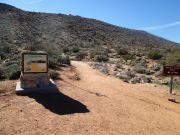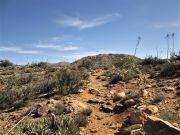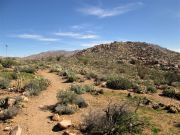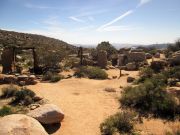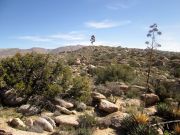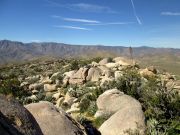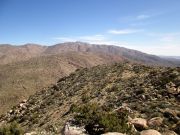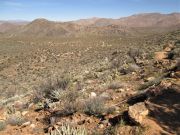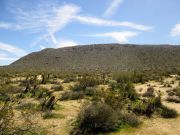
The Mountains of California
www.surgent.net |
| Ghost Mountain & Yaquitepec Ruins |
• Vallecito Mountains • Anza-Borrego Desert State Park • San Diego County |
Date: March 7, 2017
• Elevation: 3,400 feet
• Prominence: 380 feet
• Distance: 2.5 miles
• Time: 1 hour, 20 minutes
• Gain: 640 feet
• Conditions: Gorgeous blue skies
California
•
Main
•
PB
We journeyed to the Anza-Borrego Desert State park for our yearly getaway. We arrived around 8 in the evening on Saturday, planning to camp at Bow Willow campground, but all the spots were taken. We chose to camp along a dirt road a few miles up the way, where we had camped last year. This road sees little traffic. In the dark, I found a clearing off the road, and we had a simple camp, me being too lazy to erect the tent just for this one night. We slept in the front passenger seats.
The next morning, I hiked up a nearby bluff to get an elevated view of the area, eyeballing an excellent campsite farther along this road. I walked back to the car and drove us to this camp area, where two large trees have formed a canopy where we could park and set up the tent with plenty of privacy. The weather today (Sunday) was cool and very windy at times. As the day wore on, the clouds scooted through, allowing more blue skies and the sun to shine through the gray overcast.
We were near Bow Willow Creek, hemmed in by low sand-dune bluffs and badlands. We were near an old homestead, now marked only by a concrete pad, some wooden posts and shards of glass and porcelain. I don't know the history of this homestead, but it seems to have been last used probably before I was born. I walked out to explore, and also hiked up some of the badland bluffs about a mile from our camp area. That was the theme for the day: walking the area, resting, then more walking. I probably put on three or four miles just in casual walking alone.
Monday, the weather had improved considerably. The wind had ceased to essentially nothing, and there was not a cloud in the sky. The temperature was pleasant, mid-70s at the highest. I went on my longest hike, a walk north toward the lip of the main canyon and all its badlands. From camp, this ridge seemed close, but the slope was so long and gentle that it seemed I would never get to its top. Once at this lip, I looked down into the canyon, then walked along the ridge another mile. There is scattered junk up here such as food tins and car parts from about fifty years ago. Presumably, cars were allowed to drive a scant track along this ridge. The junk was not obtrusive, just little piles here and there.
I entered into proper badlands, hiking along the top ridges, and when I found a good way to exit, I dropped into the badland canyons, which opened up back onto the desert flats, then a bee-line back to our camp. βð was still asleep, so I relaxed in a camp chair or in the vehicle. Since things were mellow and no one was around, I did some math. I felt energized as a result. It was probably something on convergent series, I don't really recall.
Later in the day, we performed a task that was central to our being here this time: to have a memorial service for our cat, Sassy, who passed away a couple weeks prior at age 17. We bought a couple clay plaques, and I collected whatever quartz rocks I could locate, and found us a spot somewhere in the brush about 300 feet off the road. There, we set up the plaques, formed a cairn of quartz around them, said our goodbyes, and sang her favorite song. We're not expecting this memorial to always be there, but it's far enough out in the brush that it's unlikely someone will randomly find it, and if they do, we hope they leave it alone, and if they don't, it doesn't matter because the place itself is important.
Back at camp, we sat around, had a dinner, and enjoyed the clear starry night. Venus appeared about midway from zenith to the western horizon, visible as the sun was setting, then shining brightly until setting itself around 10 p.m.. There was a half-moon, and I entertained myself by peering at the moon with our binoculars, and the stars too. What looks like a star is shown to be a star cluster with simple binoculars. For example, look at the "dagger" part of Orion's belt through binoculars.
On Tuesday (today), I took down camp and got us rolling about 9 a.m.. We were heading home, but on the way out, I wanted to hike a peak. Before leaving on this trip, we had looked at camping in the Blair Valley area between Whale and Granite Mountains, so I had selected a few bumps in the area I could tag. One that caught my attention was Ghost Mountain. The peak itself was not terribly interesting, but I wanted to explore the Yaquitepec Ruins that lie on the peak's east ridge.
The Yaquitepec Ruins are of an old homestead from the 1930s and 1940s. A man named Marshall South, his wife and three children lived in an adobe home up on this ridge, surrounded by massive granite stones. South was a writer, poet and artist who sought to live off the grid, so to speak. They had cisterns to catch occasional rains, were able to catch or grow or forage for food, but the reality was also that he needed to support this experimental living with his writing. Many of his articles appeared in Arizona Highways. The marriage ended in divorce in 1947 and he died in 1948. The homesite was subsequently abandoned. It's an interesting story well documented on many websites.
We rolled into the parking area, the first car here today. I got my shoes and pack on, set B. up and was on my way. The sign at the trailhead says the ruins are 1 mile up the trail. The trail angles right, switchbacks up the slope, then achieves the ridge. Here, the trail angles left (east), and the terrain changes from desert plants and scrub to big rock piles of granite boulders. One short and slightly-steep uphill, and I was at these ruins. Today, just the doorway frame stands, plus two cisterns and metallic junk such as an old bed frame. I looked around for a few minutes. It would have been rough living up here. In winter, it gets cold. Being on the ridge, it is often windy, and in summer, the heat would have been unbelievable. Still, it is a beautiful place, and they managed to make it work up here for about 17 years.
Past the ruins, I found a faint path but that petered out quickly. The ridge is covered in big and small rocks, so I stayed atop these rocks, hopping from one to the next, only dropping onto the soils when I couldn't make a hop safely. The soils were laden with agave, ocotillo and cholla, but never too densely. The worst were the agave. There were a few times I needed to make a wide turn to get around a thick patch.
The climb up is mostly level, gaining just 200 feet from the ruins to the summit in about a half-mile, but there were a number of false summits. I knew this, so I was not surprised. The real summit features a large rounded boulder slightly offset to one side. I arrived to the top about twenty minutes from the ruins, and about 45 minutes since starting from the car.
The tip-top is atop this rounded boulder. A cleft on the north side allows for a good way to get up this boulder. There are a couple good footholds and in moments, I was atop the boulder, where I signed into the log book. I snapped a few photographs, enjoying the views, plus had a snack and drink break. I didn't want to linger and leave B. hanging, so I started down not long after arriving.
The hike down went well. In fifteen minutes, I was back to the Yaquitepec ruins, where some hikers had now arrived. I continued down the trail, and as I was descending, watched as literally nine vehicles arrived into the small parking lot all at once. When I got back down, about thirty people had congregated around one guy at the trailhead sign. This was clearly an organized hike of some sort. About half the vehicles had British Columbia plates on them. We didn't want to linger here amid the noise, cars and people, so I drove us to another parking area about a quarter mile away, where we relaxed and I could change into driving clothes without showing my naughty bits to all those people.
We exited by going north to Scissors Crossing, then eastbound along state route CA-78. It's been years since we followed this road. The first twenty miles are very scenic, as the road works through a couple passes and narrows, or follows long canyons hemmed in by desert peaks. Slowly, the hills peter out, the plants less thick, the desert more sandy. We passed into Imperial County, then to the CA-86 intersection (co-signed as CA-78 and 86) near the Salton Sea.
At this intersection is a hand-painted sign advertising date shakes in the town of Westmorland. Sassy would have wanted us to have a big date shake each. So in Westmorland, we stopped in the date shake store, and each got the large size, with real milk, vanilla ice cream and lots of blended dates. That combination is the best, and we slurped on our shakes for the next half hour as we drove through Brawley then east toward the Glamis dunes.
Once past the Glamis area, traffic reduced to zero and we had an easy and scenic drive back to Interstate-10 in Blythe, and from there, back home, arriving about 6 p.m.
|
|
